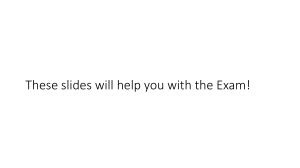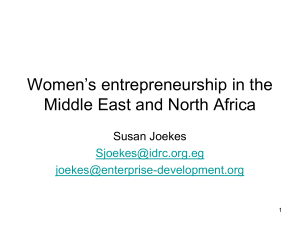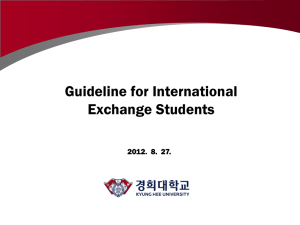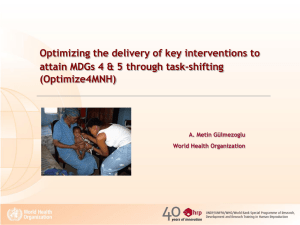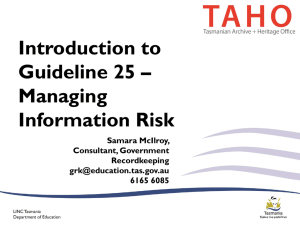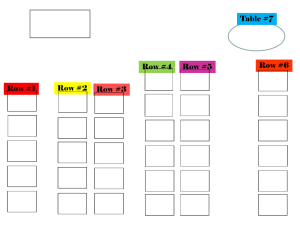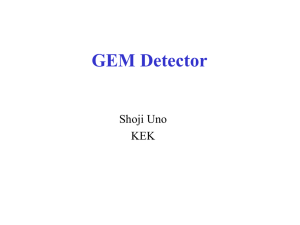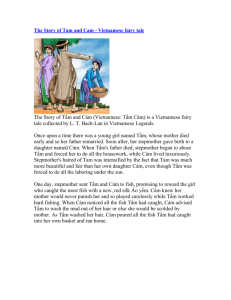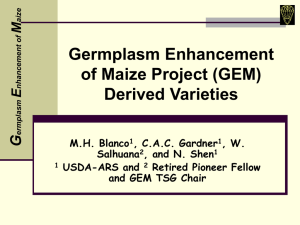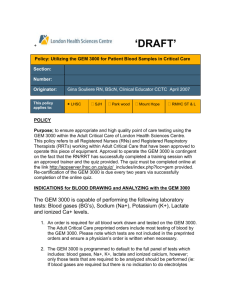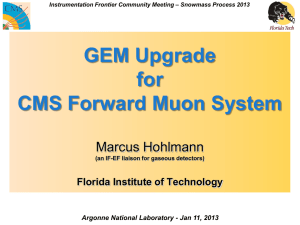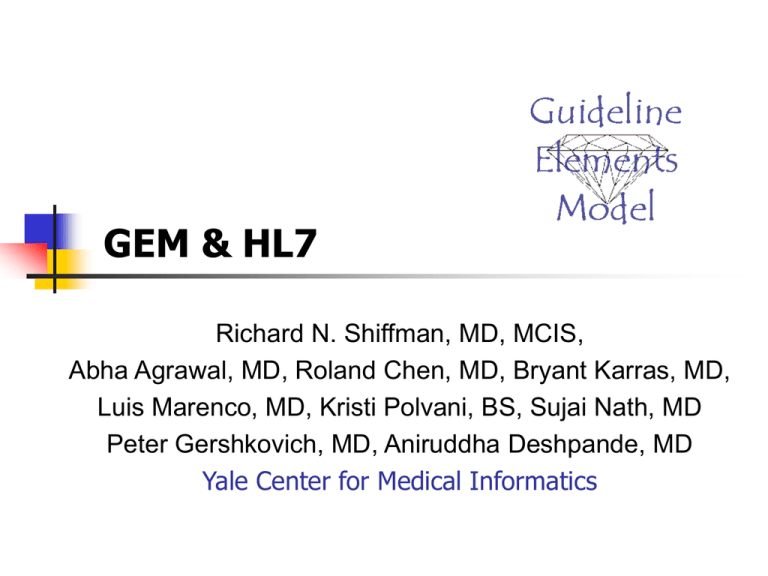
GEM & HL7
Richard N. Shiffman, MD, MCIS,
Abha Agrawal, MD, Roland Chen, MD, Bryant Karras, MD,
Luis Marenco, MD, Kristi Polvani, BS, Sujai Nath, MD
Peter Gershkovich, MD, Aniruddha Deshpande, MD
Yale Center for Medical Informatics
NOT!!
http://ycmi.med.yale.edu/GEM
richard.shiffman@yale.edu
Use And Satisfaction
8 physicians—not members of the GEM
development team (UNC, UAB, Hopkins, Yale)
marked up a guideline
CONCLUSIONS: Subjects were able to model the
content of the guideline using GEM elements.
“satisfactory”
Improved editing tools would facilitate translation
Result: GEM Cutter
Karras, Proc AMIA 2001
GEM-Q / GEM-Q OnLine
XSL stylesheet extracts info relevant to
quality appraisal from GEMified gl
Pass to Shaneyfelt and Cluzeau
instruments
Output is a quality report card
Valued by AAP in gl devel process
Available for ad hoc reports on WWW
Agrawal, Medinfo 2002
GEM to Arden
Relevant components for Arden
extracted and used to pre-populate
MLMs
Agrawal, Proc AMIA 2002
Implementation
GEMified document can dynamically
generate data collection screens and
trigger appropriate recommendations
based on guideline logic
Proof of concept
Applied to NHLBI asthma guideline and
CDC TB screening guideline
Gershkovich, Proc AMIA 2002
Knowledge extractor
XSL extracts and formats guideline info
relevant to implementation
In use
~100 guidelines have been GEMified
Groups in US, UK, Germany, Italy, and
NZ are using GEM
Funded by NLM:
To improve the quality and implementability of an AAP
guideline w/ feedback during development. (Using GEM-Q)
To create tools that transform GEM-encoded guidelines into
CDSS. A generic process and software tools will be developed
to translate GEM-encoded guidelines into systems that can
improve the process of care.
To extend and refine the GEM model to serve as a precise,
comprehensive, and consistently applied ontology of
guideline-related concepts. (Logic, link, algorithm elements;
application of advanced X-technologies)
Logical Analysis with
Highlighters
Recommendation 3
If an infant or young child 2 months to 2 years of age
with unexplained fever is assessed as being sufficiently ill
to warrant immediate antimicrobial therapy, a urine
specimen should be obtained by SPA or bladder
catheterization; the diagnosis of UTI cannot be
established by a culture of urine collected in a bag.
(Strength of evidence: good) Urine obtained by SPA or
urethral catheterization is unlikely to be contaminated...
UTI Recommendation in XML
<decision.variable id=dv1>age</decision.variable>
<value>2 months to 2 years</value>
<decision.variable id= dv2>unexplained fever </decision.variable>
<decision.variable id=dv3>sufficiently ill to warrant immediate
antimicrobial therapy </decision.variable>
<action id=a1>obtain urine specimen by SPA</action>
<action id=a2>obtain urine specimen by catheterization</action>
<reason>the diagnosis of UTI cannot be established by a culture of
urine collected in a bag</reason>
<evidence.quality>Good</evidence.quality>
<logic>IF (dv1=2m-2y) AND dv2 AND dv3 THEN a1 OR a2</logic>
<link>after: Recommendation 2</link> <link>Diagnosis section</link>
Adding guideline meta-information
•
Operationalizing abstract constructs
Sufficiently ill to warrant immediate antimicrobial
therapy
or
Febrile
•
Interactive
Tolerating oral fluids
Determining when to collect data, when to
deliver advice (site-specific)
Whither GEM in HL7
• GEM users asking why HL7 is
creating a new architecture
HS
Identity
Developer
Purpose
Audience
Method
Knowledge
Testing
Revision
INF
Title
Citation
Release Date
Availability
Contact
Status
Companion Document
Adaptation
Developer Name
Committee Name
Funding
Endorser
Comparable Guideline
Health Practices
Category
Target Population
Rationale
Objective
Available Options
Implementation Strategy
Health Outcomes
Exceptions
Care Setting
Clinician Users
Evidence Collection
Evidence Time Period
Evidence Grading
Combining Evidence
Specification of Harm/Benefit
Quantification of Harm/Benefit
Value Judgment
Patient Preference
Qualifying Statement
Cost Analysis
Recommendation
Conditional (decision variable)
.
Action
.
Logic
.
Reason
.
Strength of Recommendation
.
Evidence Quality
.
Cost
.
Certainty
.
Algorithm
Eligibility
Definition
External Review
Pilot Testing
Expiration Date
Scheduled Review
.
.
GEM: Distinguishing Characteristics
Conceived and built in XML
Multi-platform
Open standard
Human-readable yet can be processed by machine
DTD/schema allows file validation
Markup can be performed by non-programmers
…
GEM passed balloting as a standard (ASTM
E2210-02)
Goals
Comprehensive – capable of
expressing all the knowledge contained
in guidelines. Health service models
cannot express recommendations in
sufficient detail; informatics models
inadequate to model constructs that
express and support guideline validity
Goal 2
Expressively adequate to convey the
complexities and nuances of clinical
medicine while remaining
informationally equivalent to the
original guideline; tagged elements
store actual language
Goal 3
Flexible – must be able to deal with
variety and complexity of guidelines;
permit modeling at high and low levels
of granularity
Goal 4
Comprehensible – the model should
match the stakeholder’s normal
problem-solving language and allow
domain experts to describe their
knowledge with little effort; markup
should not require a background as a
programmer
Goal 5
Shareable across institutions
Goal 6
Reusable - across all phases of the
guideline lifecycle
GEM: Major Components
Guideline
Document
Header
Identity
Developer
Document
Body
Purpose
Method of
Development
Intended
Audience
Testing
Target
Population
Revision
Plan
Knowledge
Components
Recommendation
Pilot Testing
Target Popul’n
Intended User
Method of Dev
Developer
Identity
Unit of implementability
Identity
Identity
Title
Citation
Length
Release
Date
Availability
Electronic
Print
Status
Contact
Companion
Adaptation
Document
Patient
Resource
Developer
Developer
Developer
Name
Developer
Type
Committee
Name
Committee
Expertise
NGC Controlled
Vocabulary
Committee
Member
Member
Expertise
Funding
Endorser
Comparable
Guideline
Purpose
Purpose
Main Focus
Category
Rationale
Objective
Available
Option
Implem’n
Strategy
Health
Outcome
Exception
Intended Audience
Intended
Audience
User
Clinical
Specialty
Professional
Group
Care
Setting
Method of Development
Method
of
Development
Descrip’n
Evid
Evidence
Time
Collection Period
Method
Evid
Collect
Number
Source
Docs
Method
Descrip’n
Spec’n Quant
Role
Role
Cost
Evidence Evidence
Harm
Harm
Value
Pt
Anal
Grading Combinat’n
Benefit Benefit Judgmt Pref
Rating
Scheme
Method
Evidence
Combinat’n
Qualifying
Statement
Target Population
Target
Population
Eligibility
Inclusion
Criterion
Exclusion
Criterion
Age
Sex
Testing
Testing
External
Review
Review
Method
Pilot
Testing
Revision Plan
Revision
Plan
Expiration
Scheduled Review
Knowledge Components
Knowledge
Components
Recommendation
Conditional
Imperative
Algorithm
Definition
Term
Term
Meaning
Action
Step
Condit’l
Step
Branch
Step
Sync
Step
Conditional
Knowledge
Components
Recommendation
Conditional
Dec
Var
Value
Action
Reason
Dec
Variable
Descripn
Sensitivity
Evid
Quality
Test
Param
Specificity
Recmdn
Strength
Dec
Var
Cost
Flexblty
Action
Benefit
Predictive
Value
Action
Risk
Harm
Logic
Cost
Action
Descripn
Link
Ref
Action
Cost
Certainty
Conditional
Knowledge
Components
Recommendation
Conditional
Dec
Var
Action
Value
Sensitivity
Reason
Dec
Variable
Descripn
Specificity
Evid
Quality
Test
Param
Recmdn
Strength
Dec
Var
Cost
Predictive
Value
Flexblty
Action
Benefit
What
Action
Risk
Harm
How
Much
Logic
Cost
Action
Descripn
Where
Link
Ref
Action
Cost
When
Who
Certainty
Actions
What
Medication
Lab test
Procedure
Consultation
Pt Education
Disposition
How
(much)
Where When
Who
GEM Cutter
Knowledge customization
•
•
Add meta-information necessary for implementation, e.g.
• Identifier, clinical source, interface, prompt, mechanism
of actions
Local adaptation
• Translation of national recommendations into systems
that operate at a local level
• Must account for legitimate variations in clinical
settings, populations served, and resources available
• Danger: protection of professional habit or economic
self-interest
Strengths of GEM
Hierarchy is relatively intuitive
Elements are derived from published models
Value-added applications have been
developed
Stable >1 year
Designation as a standard
GEM Limitations
Has been “frozen” > 1 year
Not comprehensive (as demonstrated by CPGA)
Need guidelines for extension
GEM file only as good as guideline document
Requires training to use correctly
Need to develop <link>, <logic>, and
<algorithm> elements

